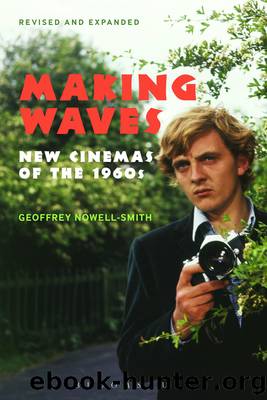Making Waves by Geoffrey Nowell-Smith

Author:Geoffrey Nowell-Smith
Language: eng
Format: epub
Tags: New Cinemas of the 1960s
Publisher: Bloomsbury Publishing
Published: 2013-08-14T16:00:00+00:00
Part III
Movements
10
Britain: From Kitchen Sink to Swinging London
Britain’s best known contribution to the new cinemas of the 1960s started early and was over almost before the 1960s proper had got underway. This was the movement known variously as ‘Free Cinema’, ‘British working-class realism’, ‘kitchen-sink realism’, and (retrospectively) as the ‘British New Wave’. The movement had three main protagonists: Lindsay Anderson, Karel Reisz, and Tony Richardson. Their first films were documentaries, made in the mid-1950s. They then graduated to feature film making: Richardson with Look Back in Anger (1959), The Entertainer (1960), A Taste of Honey (1961), and The Loneliness of the Long Distance Runner (1962);1 Reisz with Saturday Night and Sunday Morning in 1960, and finally Anderson with This Sporting Life in 1963. Other films associated with the movement include John Schlesinger’s A Kind of Loving (1962) and Billy Liar (1963), and, somewhat to one side, Jack Clayton’s Room at the Top (1959). Anderson was always acknowledged as the leader of the group and when This Sporting Life, his much-trumpeted first feature, turned out to be a critical disappointment and a box-office failure, the movement imploded. Anderson, Reisz, Richardson, and Schlesinger went on to make further films, but of a different type than had brought them to fame.
None of the terms used to describe the movement is satisfactory. ‘Working-class realism’ is restrictive but probably the least inaccurate. ‘Kitchen-sink realism’, a derogatory label originally given to the painting of John Bratby and others in the 1950s, is not even accurate, since, apart from Look Back in Anger and possibly A Taste of Honey, the films do not have particularly domestic settings. (James Hill’s 1961 adaptation of Arnold Wesker’s play The Kitchen does have a kitchen in it, but not a domestic one.) To the extent that ‘working-class realism’ is accurate, however, it suggests a movement that was not only limited but self-limiting and narrows the field down to a handful of films falling far short of actually being a ‘new wave’ in the same sense as the Nouvelle Vague in France. As for ‘Free Cinema’, widely used by continental writers but less often in Britain, it is strictly speaking a misnomer but has the advantage of pointing to the role the British example played in the panorama of new cinemas across the world in the 1960s. Like ‘New Wave’, the phrase ‘Free Cinema’ had a resonance that extended far further than its original application.
The original Free Cinema was an event held on 5 February 1956 at the National Film Theatre in London. Three short or medium-length films were shown: a documentary called Momma Don’t Allow by Reisz and Richardson, about a jazz club in north London; a documentary by Anderson about an amusement park in the seaside resort of Margate, entitled O Dreamland; and a 50-minute fiction film by Lorenza Mazzetti, Together, loosely based on a story by Carson McCullers. The screening was accompanied by a manifesto, signed by the four film-makers, which read as follows:
These films were not made together; nor with the idea of showing them together.
Download
This site does not store any files on its server. We only index and link to content provided by other sites. Please contact the content providers to delete copyright contents if any and email us, we'll remove relevant links or contents immediately.
The Kite Runner by Khaled Hosseini(4435)
Gerald's Game by Stephen King(3918)
The Perils of Being Moderately Famous by Soha Ali Khan(3782)
Dialogue by Robert McKee(3582)
Story: Substance, Structure, Style and the Principles of Screenwriting by Robert McKee(2986)
The 101 Dalmatians by Dodie Smith(2936)
The Pixar Touch by David A. Price(2740)
Confessions of a Video Vixen by Karrine Steffans(2675)
Fantastic Beasts: The Crimes of Grindelwald by J. K. Rowling(2543)
How Music Works by David Byrne(2526)
Slugfest by Reed Tucker(2416)
Harry Potter 4 - Harry Potter and The Goblet of Fire by J.K.Rowling(2416)
The Mental Game of Writing: How to Overcome Obstacles, Stay Creative and Productive, and Free Your Mind for Success by James Scott Bell(2393)
Wildflower by Drew Barrymore(2118)
Scandals of Classic Hollywood: Sex, Deviance, and Drama from the Golden Age of American Cinema by Anne Helen Petersen(2109)
Casting Might-Have-Beens: A Film by Film Directory of Actors Considered for Roles Given to Others by Mell Eila(2071)
Screenplay: The Foundations of Screenwriting by Syd Field(2057)
Robin by Dave Itzkoff(2005)
The Complete H. P. Lovecraft Reader by H.P. Lovecraft(1977)
